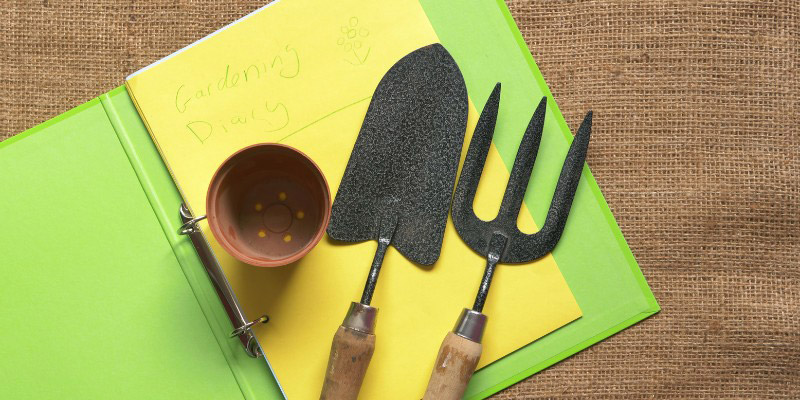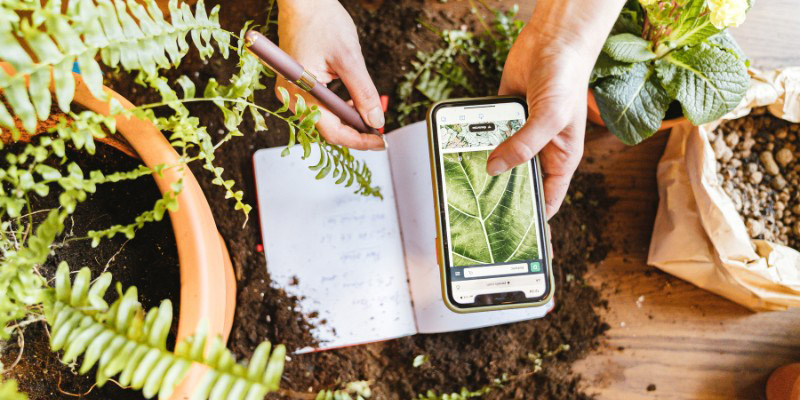Because it's not always easy to remember what was planted, what worked or failed in garden from one year to the next… a garden journal, gardener's diary or gardening notebook is a fantastic organisational tool for every gardener. A true memory aid, it allows recording, month by month and year by year, information about maintenance, plantings and harvests, from garden layout to planning and management of seed. Here’s how to create a super-practical garden journal to plan and track garden progress through seasons!
Materials needed
- blank notebook
- pens, felt-tip pens or highlighters
- ruler
- pencils, coloured pencils
- gum
- glue, adhesive tape, stickers (facultative)
- pair of scissors
Why keeping a garden journal?
Why not?! Whether gardening in open ground or on a small balcony, organising plantings is essential. A garden notebook or planting journal will accompany you through gardening adventures, helping to optimise actions. It becomes memory, privileged record of progress as gardener. It is above all an indispensable tool to keep track of everything happening in garden. It helps plan projects for year, anticipate and monitor sowing, pricking out, pruning, treatments, watering and harvests. You can note tasks to do and deadlines to meet to ensure good development of plant. It's also a way to keep a permanent record of little victories, but also of biggest failures, very useful to learn from mistakes! This logbook is an excellent way to pass on knowledge to other gardeners, whether family, friends or association members, and to contribute to preservation of horticultural know-how.

What to put in a garden journal?
There are no rules or limits for filling pages of gardening notebook! As you wish, you can record:
- layout of garden, vegetable garden or balcony
- the sowing and planting calendar and harvest dates
- cultivation sheets for plant
- labels for your young plants and seed packets
- flowering dates of certain bush or perennial, date of first mow
- day-to-day observations and tasks carried out
- wish list of new plant
- those that succeeded and those that didn’t work
- record of expenses
- gardening tips and tricks
- recipes using vegetables from garden
- photos, drawings, magazine clippings
- leaves or dried flowers in herbarium style
- the recipes for natural insecticidal products you have tested
- season review: successes and failures
Which type of notebook to choose?
School exercise book, small pocket notebook or binder with loose leaves, kraft paper, squared, plain or recycled, choice of notebook for garden depends on personal preferences and needs. Here are some suggestions to help:
- notebook with binding (spiral or ring) allows adding, removing or reorganising pages easily. You can personalise notebook according to garden evolution.
- hardcover notebook offers better protection for notes and drawings, especially if working in garden with notebook nearby and hands full of soil.
- notebook with integrated pockets useful to keep plant labels, seed packets or magazine articles.
- digital notebook: computer, tablet or smartphone? This allows taking notes, adding photos and consulting gardening information wherever you are.

How to create gardening journal?
Our preference is for homemade paper logbook in « bullet journal » style to plan and organise gardening life efficiently and creatively. To create a practical and useful garden notebook, follow these steps:
- Choose a blank notebook: pick one you like and that meets needs (size, binding, cover, etc.). Make sure it is thick and sturdy enough to withstand outdoor use.
- Create a key: at start of notebook, create a key with symbols and colours to represent different tasks, events and categories related to garden (sowing, planting, harvest, flowering, watering…).
- Create trackers (or "suivis" in French) for watering, weeding, harvest, expenses (as tables with checkboxes, charts, calendars or lists). They help monitor tasks, routines and little victories for year, month, week, day…
- Create an index page: reserve a few pages at start of notebook to make an index. This helps find different sections quickly.
- Organise journal: divide notebook into collection pages (thematic pages interspersed with planning pages) to make information easier to find (annual and monthly sowing, planting and harvest calendars, crop locations, sketches, notes, tips, recipes...)
- Personalise notebook: feel free to stick photos of garden, plant labels and other visual elements to personalise journal and keep track of plantings.
- Get into habit of updating garden journal regularly to track plant progress and plan upcoming tasks. And above all, let creativity speak!

































Comments